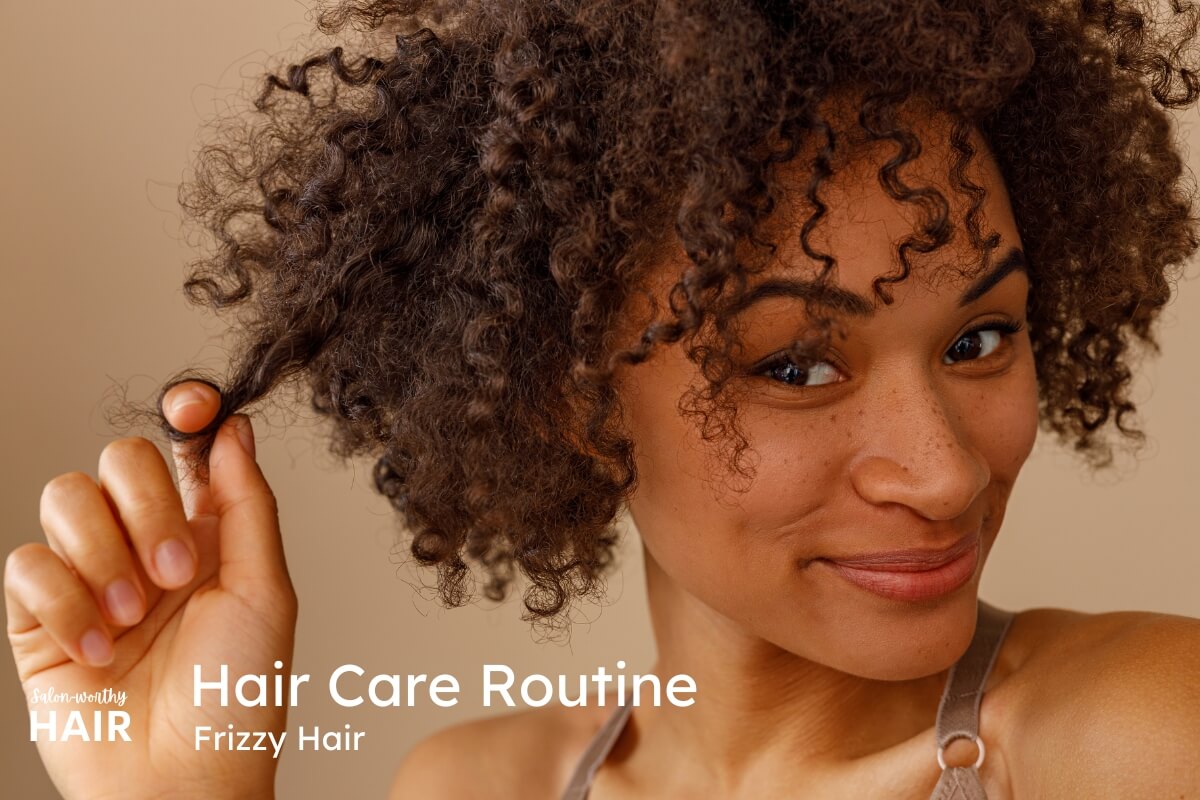Hair Care Routine for Frizzy Hair: Cleanse, Condition, Style, and Protect
Updated on
This post may contain affiliate links. As an Amazon Associate, we may earn from qualifying purchases.

A hair care routine is a structured series of steps to maintain the health, look and feel, hygiene, and nourishment of the hair and scalp.
The steps can be divided into 5 distinct categories:
- Cleansing
- Conditioning
- Moisturizing
- Drying and Styling
- Protection
Each step in a hair care routine addresses specific hair needs or concerns such as hair damage, dry hair, or frizzy hair.
Frizzy hair is a hair concern that refers to the lifting or separating of cuticles, causing hair to appear dry, tangled, and unkempt. Frizz can result from various factors, including humidity, hair damage, dehydration, or certain hair types.
Many people seek products and treatments to address and manage frizzy hair. However, products and treatments can only be effective if used correctly within a consistent hair care routine.
If you’re unsure how to start yours, here’s a step-by-step hair care routine for frizzy hair you can try.
Note: You don’t strictly need to follow all the steps below – Experiment and see what works best for you.
Table of Contents
1. Cleanse
Start With a Pre-Shampoo Treatment
Add a pre-shampoo treatment to your hair care routine if you have dry, frizzy hair.
A pre-shampoo treatment or “pre-poo” involves applying a hydrating oil, hair butter, hair mask, or conditioner to the hair before shampooing. It primes the hair for the washing process to smooth the cuticles, add moisture, soften the hair, reduce tangles, and protect from harsh surfactants in shampoos.
Do the pre-shampoo treatment 1-2 times per week. After application, let it soak in for 5-15 minutes before shampooing.
Wash Your Hair With Lukewarm Water
Hair must be washed with lukewarm water between 90°F to 100°F (32°C to 38°C). This temperature is neither too hot nor too cold. Lukewarm water helps open hair cuticles to wash out impurities without causing frizz or damage.
Water above 110°F (43°C) should be avoided when washing the hair. Hot water can swell the cuticles and make them open wider, exposing the delicate inner structures of the hair. Hot water also aggressively washes away the natural oils, leaving the hair dryer and more prone to frizz. Very hot water, over 120°F, can also scald the scalp, causing discomfort.
Use a Sulfate-free Moisturizing Shampoo
A sulfate-free shampoo gently cleanses the hair without stripping moisture.
Sulfates are cleansing agents commonly found in shampoos. They create the lather and foam that helps remove dirt, oil, and product buildup from the hair and scalp. However, sulfates can be harsh for some hair types as they strip the hair’s natural oils and moisture.
Frizzy hair tends to be drier and more delicate. The cuticles on each hair strand stand up, creating roughness and lack of definition. Using a shampoo with sulfates can exacerbate the hair’s dry and frizzy texture by over-cleansing and depleting moisture.
A sulfate-free shampoo uses milder cleansers, natural oils, butters, and humectants to cleanse the hair while hydrating and conditioning. Look for shampoos with glycerin, shea butter, jojoba oil, and babasu oil.
When washing the hair, concentrate the shampoo more on the scalp than the length of your hair.
How Often to Wash Frizzy Hair?
Wash frizzy hair 2-3 times per week. Washing too frequently, like daily, can cause over-cleansing, dryness, and worsen frizz. Some people can even stretch to washing just once a week. Adjust the frequency based on activities – wash after workouts, swimming, etc., which causes more oil and sweat buildup.
How to Stop Frizzy Hair After Shower?
To stop frizzy hair after washing, follow the 3 rules of hydration, eliminate friction, and cuticle sealing during the washing process. These rules include thoroughly conditioning your hair, avoiding rough drying, and using serum or leave-in products to smooth the hair cuticles.
Read more: My 3 post-shower tips to stop frizzy hair after washing.
2. Condition and Detangle
Apply Conditioner
Hair conditioner hydrates, rebalances the hair’s pH, and seals the cuticles after shampooing. The combination of moisture, balanced pH, and a flat and smooth cuticle layer makes the hair less prone to frizz after your shower.
Hair conditioner is formulated with humectants, occlusives, oils, and emollients. Humectants like glycerin or panthenol attract and retain water. Oils and emollients like shea butter or argan oil lock moisture in, ensuring it remains within the hair strand and doesn’t evaporate readily.
Apply the hair conditioner from the mid-lengths of hair down to the ends. Do not apply conditioner to the scalp or roots. Let it soak in for 2-3 minutes. This allows it to penetrate the hair shaft and smooth the cuticle to give the hair more “slip” for detangling.
Detangle Hair With A Wide-Tooth Comb
Once your hair is saturated with conditioner, use a wide-tooth comb to gently detangle your strands, starting from the bottom and working up. The conditioner acts as a lubricant that allows the comb to glide through and untangle hair without snagging or pulling. Be sure to detangle thoroughly from tip to root.
Rinse Hair With Cold Water
A cold water rinse makes the outer layer of the hair lie flat by constricting the cuticles and reducing swelling after washing. Cool water also traps the hydrating ingredients from the conditioner inside the hair shaft instead of washing them away.
As a result, the tightened cuticle reflects more light for enhanced shine rather than the duller look of rough, open cuticles. By preventing the absorption of excess humidity, the cold water rinse leads to less frizzing.
Gently Blot Dry Hair With Microfiber Towel
After washing your hair, gently blot or squeeze the excess water using a microfiber towel.
Microfiber towel is soft and ultra-absorbent. Microfiber absorbs significantly more water per square inch than regular cotton towels. It dries hair quickly with less friction.
A microfiber towel has delicate and smooth fibers that don’t roughen up the cuticle to cause frizz like regular terry cloth towels can. The soft microfibers are less likely to snag, pull, or damage hair than woven cotton fibers.
Once the microfiber towel has soaked up all the dripping wetness, you can add leave-in products to damp hair.
3. Moisturize
Apply a Leave In Conditioner
Apply leave-in conditioner while the hair is still damp. Leave-in conditioner provides extra hydration and can act as a foundation for other products, ensuring they spread more evenly and effectively.
Apply a Hair Serum to the Ends of Your Hair
Once the leave-in conditioner has been applied and has had a moment to absorb, you can apply the hair serum. This product can help reduce frizz, add shine, and offer some protection from heat.
4. Dry and Style
Depending on your preference, You can air dry or use a blow dryer.
Air Drying
Air drying is recommended for individuals with frizzy hair because it maintains moisture levels, preserves natural texture, and prevents heat damage.
However, it’s essential to know how to air dry properly. Using leave-in conditioners, anti-frizz serums, or hydrating products can enhance air drying, ensuring the hair remains moisturized and frizz is minimized.
Read more: How to air dry hair without frizz.
Blow Drying
Blow drying frizzy hair requires careful techniques to achieve a smooth and frizz-free result.
First, a high-quality hair dryer with multiple heat settings and a cool shot option is necessary. Technique is also important because how you hold the hair dryer, the distance from the hair, and how you direct the airflow can make a big difference in reducing or worsening frizz.
Straightening
Straightening frizzy hair can be transformative, offering a sleek, polished appearance. Before applying direct heat, always use a heat protectant; it shields hair from potential heat damage and creates a barrier against frizz.
Use a high-quality straightener with adjustable temperature settings. For those with fine hair, a lower temperature setting is advisable, while thicker hair may require higher heat. The key is to find a balance to straighten effectively without excessive heat. Sectioning the hair ensures even application and allows focused attention on each part, reducing the need for multiple passes with the straightener.
5. Protect
Use an Anti-Humidity Spray
Anti-humidity sprays protect hair from frizziness, especially in conditions laden with moisture. At its core, frizzy hair results from the hair strand’s attempt to absorb moisture from the air, causing it to swell and disrupt the cuticle layer. Cuticle disruption is particularly evident in hair types that are naturally dry or porous.
An anti-humidity spray acts as a shield, creating a barrier around the hair strand. This barrier prevents external moisture from penetrating the hair shaft, ensuring it remains smooth and frizz-free. The ingredients in these sprays, often including silicones and polymers, seal the hair cuticles, making them impermeable to the surrounding moisture.
Additionally, the protective layer provided by the spray gives the hair a smoother appearance, reflecting light better and thus imparting a shiny finish. By controlling the hair’s exposure to excess moisture, anti-humidity sprays keep hair manageable, sleek, and free from the undesirable effects of frizz.
Night Care
Brush Hair Before Bed
Brushing hair with a boar bristle brush before bed removes tangles and distributes the scalp’s natural oils through the lengths of the hair to keep it moisturized and frizz-free overnight.
A boar bristle brush has natural flexible bristles made from boar hair. The natural flexibility of the bristles gently detangles the hair without breakage. The bristles also distribute the scalp’s oil (sebum) through the hair, laying the cuticles flat and smooth. As a result, the hair is less prone to tangles, knots, and frizz overnight.
Sleep on Silk Pillowcase
Silk pillowcase has a smooth, slippery, and non-absorbent surface, allowing the hair to glide without getting tangled. Unlike cotton pillowcases that pull and tangle the hair, silk surfaces cause less friction against hair.
With reduced friction, moisture loss, and tangles, silk results in fewer flyaways and smoother, sleeker hair in the morning.
Read more: How to keep hair frizz-free while you sleep.
Be Consistent
A frizzy hair care routine requires commitment and consistency for optimal results.
Whether cleansing, conditioning, styling or overnight care, each part of the routine must become a customary practice.
Consistency is key – the more often the optimized hair care steps are followed, the greater the cumulative benefit. With regular hydrating treatments, proper washing techniques, using the right products, and protecting against environmental elements, frizzy locks can be tamed and managed.
So, commit fully to a routine tailored for frizzy hair and prioritize each step on a consistent, ongoing basis.
About the Author
 Shehnaz Shirazi
Shehnaz ShiraziShehnaz Shirazi has been writing in the beauty and cosmetics industry for over 8 years, sharing her expansive hair care and beauty knowledge. Shehnaz researches and tests new hair care trends and publishes her insights here.